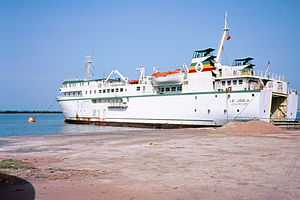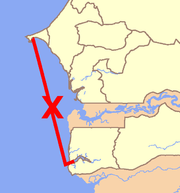MV Le Joola
 Ferry Le Joola at Ziguinchor, Senegal in 1991 | |
| Career (Senegal) | |
|---|---|
| Name: | Le Joola |
| Owner: | Republique Senegal, Ministere de l'Equipement, Dakar / Senegal |
| Operator: | Armed Forces of Senegal |
| Port of registry: |
|
| Route: | Dakar to Casamance |
| Builder: | Schiffswerft Germersheim GmbH (Germany) |
| Acquired: | 1990 |
| Out of service: |
September 13, 2001 – September 10, 2002 Mechanical damage repair and replacement of the port side engine |
| Identification: | Call sign 6VYZ |
| Fate: | Capsized and sunk in rough seas September 26, 2002 |
| Status: | Wreck |
| Notes: | The ship was overloaded with an estimated 1,863 aboard at the time of disaster. |
| General characteristics | |
| Class and type: | Roll-on/roll-off ferry |
| Tonnage: | 2087 gross |
| Length: | 79.5 meters |
| Beam: | 12 meters |
| Draft: | 3.1 meters |
| Capacity: | 536 passengers 35 cars |
| Crew: | 44 |

MV Le Joola was a Senegalese government-owned ferry that capsized off the coast of the Gambia on September 26, 2002,[1] with 1,863 deaths and 64 survivors. It is thought to be the second-worst non-military disaster in maritime history.
The ship was plying the route from Ziguinchor in the Casamance region to the Senegalese capital, Dakar, when it ran into a violent storm, farther out to sea than it was licensed to sail. The estimated 2000 passengers on-board amounted to at least three times as many as the ship was designed to hold, and only about half of them had tickets. The large numbers sleeping on deck added further instability. Rescue operations did not start for several hours.
A government inquiry principally blamed negligence, and accusations were levelled at both the Senegalese president and prime minister.
The ship
The ship was named Le Joola after the Jola people of southern Senegal. It was constructed in Germany and was put to sea in 1990. She was 79 m (259 ft) long and 12 m (39 ft) wide, had two motors and was equipped with some of the latest safety equipment available at the time of the disaster. Le Joola usually traveled twice a week and often carried women who wanted to sell mangoes and palm oil on the market of Dakar. At the time of the disaster, the ship had been out of service for almost a year undergoing repairs which included replacement of the port side engine.
Last voyage
On September 26, 2002, Le Joola set sail from Ziguinchor in the Casamance region on one of its frequent trips between southern Senegal and the country's capital Dakar. It was about 1:30 pm. Although the ship was designed to carry a maximum of 580 passengers and crew, an estimated 1,863 passengers are believed to have been on board, including 185 people who boarded the ship from Carabane, an island where there was no formal port of entry or exit for passengers. The exact number of all passengers remains unknown (some Senegalese based organizations put the number at over 2,000), but there were 1,034 travelers with tickets. The rest of the passengers were either not required to hold tickets (children aged less than 5) or had been permitted to travel for free, as often happened.[2]
The last call from the ferry staff was broadcast to a maritime security center in Dakar at 10 pm and reported good travel conditions. At around 11 pm, the ship sailed into a storm off the coast of Gambia. As a result of the rough seas and wind, the ferry capsized, throwing passengers and cargo into the sea. Detailed reports indicate that this happened in less than five minutes.
While many of the ship's passengers may have died during or immediately following the capsizing, a large number probably survived, only to drown whilst awaiting rescue. Government rescue teams did not arrive at the scene until the morning following the accident, although local fishermen rescued some survivors from the sea several hours before. Only 64 passengers survived, including only one woman (Mariama Diouf, who was pregnant at the time) from more than 600 female passengers aboard.[3]
Some time before official rescue teams arrived, it was local fishermen with pirogues in the area of the tragedy who started the first efforts to pull survivors out of the water. They were able to rescue a few people but also recovered several bodies that were floating around Le Joola. At 2 pm, they rescued a 15 year-old boy. The boy confirmed that there were still many people trapped alive inside the ship; there were reports of noises and screaming coming from within.[4]
Le Joola remained capsized but afloat until around 3:00 pm, at which point she finally slid beneath the water's surface, taking with her those who were unable to get out of the ship.[2]
Causes
The huge loss of life caused by the tragedy was a great shock to many in Senegal and immediately led to calls from the press and public for an explanation of the disaster. The Senegalese government established an inquiry to investigate. The French courts also launched a probe into the disaster as several French nationals were among the dead. According to many sources, the accident was caused by a variety of factors, including possible negligence. While rough seas and wind were directly responsible for the capsizing, the ferry was built only to be sailed in coastal waters but was sailing beyond this coastal limit when it capsized. Overcrowding is one of the most commonly mentioned factors in the disaster, both for the capsizing and the high number of deaths. Due to the heat and claustrophobic conditions below deck, as many passengers as possible usually slept on the upper level, making the ship more unstable. The ship was only 12 years old and was built to be in service for at least 30 years but had suffered a number of technical problems in the years before it capsized. These problems are now attributed to poor maintenance by its owners and not to any design or manufacturing flaws.[5]
Deaths
At least 1,863 people died, although the exact number will never be known due to a large number of unticketed passengers on board. Among the dead were 1,201 men (61.5%) and 682 women (34.9%). The gender of 70 victims could not be determined. The dead included passengers from at least 11 countries: Cameroon, Guinea, Ghana, Nigeria, France, Spain, Norway, Belgium, Lebanon, Switzerland and the Netherlands.
On September 28, 2002, environmental activist Haïdar El Ali and his diving team explored the disaster area. They saw no survivors, but many bodies of men, women and children inside the ship. 300 corpses trapped inside were freed. Another 100 that were around the ship were also recovered. 551 dead bodies were recovered in total. Of that number, 93 were identifiable and given back to families. The remaining bodies were put to rest in specially-constructed cemeteries in Kabadiou, Kantene, Mbao and on the Gambian coast. National funerals were held on October 11, 2002, at the Esplanade du Souvenir in Dakar.
Aliou Cisse and Birmingham City Football Club
Senegalese footballer Aliou Cisse lost several members of his family in this tragedy, and his club Birmingham City, in England, displayed coloured cards, which showed the Senegalese flag, to remember their midfielder's family, and all the other people who lost their lives.
Reparations and memorials
The Senegalese government initially offered families a payment of around US$22,000 per victim and fired several officials, but no one has ever been prosecuted, and the official report was closed a year after the disaster.[6] Officials, including high-ranking members of the Armed Forces of Senegal who were moved to other posts, were charged with failure to respond quickly enough to the disaster, but little light was ever cast upon those responsible for allowing the ferry to be overloaded or poorly maintained. The Prime Minister at the time, Mame Madior Boye was dismissed by President Abdoulaye Wade after the disaster with much of her cabinet, reportedly for mishandling the rescue.[7] In the 2007 election, Wade's rival and former Prime Minister, Moustapha Niasse, accused Wade of covering up their responsibility for the disaster.[8] Families of victims, many of whom have been unwilling or unable to claim reparation, have continued to be highly critical of the government over its handling of the rescue, the operation of the ferry which led to the disaster, and the reparation process.[9]
The families of French victims refused the 2003 reparations packages, and have pursued the Senegalese authorities in French courts. On September 12, 2008, a French judge handed down an indictment of nine Senegalese officials, including Former Prime Minister Boye and former Army Chief of Staff General Babacar Gaye. Senegalese official and popular reaction against these charges coming from the former colonial power have been hostile, with the Senegalese government saying they may pursue an indictment of French judge, Jean-Wilfrid Noël in return.[10]
A documentary by Senegalese journalist Papa Moctar Selane was shown for the first time on the ninth anniversary of the tragedy, September 26, 2011. It tells the story of some of the survivors and questions again the slow rescue work.[11]
Status of disaster
The sinking of Le Joola is thought to be the second-worst non-military maritime disaster in number of lives lost. The first is considered to be the MV Doña Paz in 1987 with an estimated number of over 4,000 dead. The RMS Titanic, which sank in 1912 with 1,517 lives lost, would be third according to the World Almanac and the New York Times.
See also
- Maritime disasters
- List of ship launches in 1990
- List of shipwrecks in 2002
References
- ↑ "Hundreds lost as Senegal ferry sinks". BBC News. September 27, 2002.
- ↑ 2.0 2.1 "Q&A: What caused the Joola ferry disaster?". BBC News. October 1, 2002.
- ↑ "Search ends under Senegal ferry". BBC News. October 1, 2002.
- ↑ "Senegal army 'left' ferry survivors". BBC News. November 6, 2002.
- ↑ Ramirez, Luis (November 4, 2002). "Senegal President Dismisses Prime Minister". Voice of America.
- ↑ "Senegal Marks Anniversary of Ferry Disaster Amid Court Cases". Voice of America. September 26, 2008.
- ↑ "Report blames army for delay in Joola rescue". IRIN. November 6, 2002.
- ↑ Colombant, Nico (February 10, 2007). "Senegalese Candidates Trade Accusations on Campaign Trail". Voice of America.
- ↑ "Senegal: Families Demand Justice for Joola Ferry Deaths". IRIN. September 19, 2008.
- ↑ "Senegal: Country And France in Legal Battle Over Ferry Disaster". The Nation (Nairobi). September 29, 2008.
- ↑ Sene, Fatou K. (September 27, 2011). "Film - Le Joola, l'ancre du souvenir de Papa Moctar Sélane". Walfadjri (in French). allAfrica.com.
Further reading
- Barry, Jessica (March 3, 2003). "Senegal ferry disaster reveals need for psychological support". International Red Cross.
- Torre, Luis Jar (November 2003). "Una masacre africana – el naufragio del Joola" (Spanish). Revista General de Marina.
External links
- Final report into the cause of the sinking (French). Government of Senegal. November 4, 2002. Archived from the original on May 25, 2011.
- Official website of the Association of the Families of the Victims.
- To ναυάγιο του MV Le Joola 26η Σεπτεμβρίου του 2002.